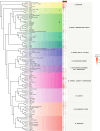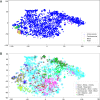What are we learning with Yoga? Mapping the scientific literature on Yoga using a vector-text-mining approach
- PMID: 40440353
- PMCID: PMC12121831
- DOI: 10.1371/journal.pone.0322791
What are we learning with Yoga? Mapping the scientific literature on Yoga using a vector-text-mining approach
Abstract
The techniques used in yoga have roots in traditions that precede modern science. Research shows that yoga enhances quality of life and well-being, positively impacting physical and mental health. As yoga gains acceptance in Western countries, scientific studies on the subject increase exponentially. However, many of these studies are considered inconsistent due to the diverse methodologies and focuses in the field, which creates challenges for researchers and hampers progress. This study aims to develop a comprehensive framework for existing literature on yoga, facilitating multidisciplinary collaboration and bringing new light to relevant aspects. Given the complexity of the subject, advanced modeling techniques are necessary. Contemporary artificial intelligence methods have advanced Bioinformatics, including text mining (TM), allowing us to employ vector representations of texts to derive semantic insights and organize literature effectively. Based on TM resources, we provided a better general understanding of yoga and highlighted the relationships between yoga practice and various domains, including biochemical parameters and neuroscience. It also reveals that practitioners can learn to engage with their bodies and environments actively, enhancing their quality of life. However, there is a lack of research exploring the mechanisms behind this learning and its potential for further enhancement. Vector TM has made it possible to bolster and improve human analysis. The set of resources developed allowed us to determine the mapping of the literature, the analysis of which revealed 4 dimensions (exercise, physiology, theory and therapeutic) divided into 9 cohesive groups, representing the trends in the literature. The resulting platforms are available to Yoga researchers to evaluate our findings and make their forays into the existing literature.
Copyright: © 2025 Ieger-Raittz et al. This is an open access article distributed under the terms of the Creative Commons Attribution License, which permits unrestricted use, distribution, and reproduction in any medium, provided the original author and source are credited.
Conflict of interest statement
The authors have declared that no competing interests exist.
Figures






References
MeSH terms
LinkOut - more resources
Full Text Sources
Research Materials

